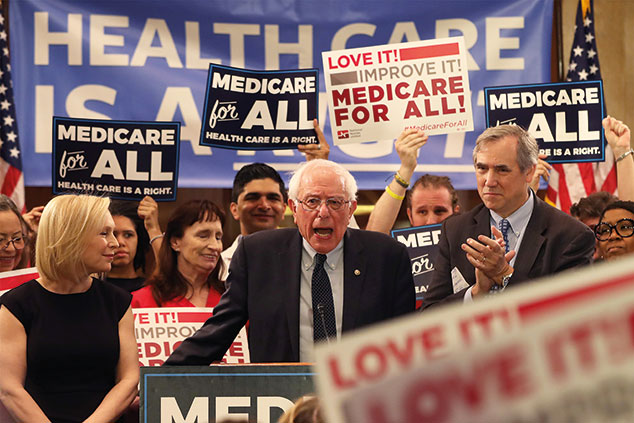
What’s happened?
Healthcare is emerging as a key issue in the US presidential election. Last week Democratic hopefuls at a presidential primary debate clashed repeatedly over how to reform the system. They are battling over electorally fertile terrain. A FiveThirtyEight/Ipsos poll shows that Democratic primary voters rank healthcare as their most important election issue ahead of even “the economy and jobs”. There are growing calls from the party’s left for dramatic reform.
What’s the current situation?
Data from the US Census Bureau shows that last year 67% of residents were covered by private-sector health insurance. Of these, four-fifths of policies were linked to employment, with the rest purchased separately. Just over one-third of Americans are covered by government schemes. “Medicare” covers those over the age of 65; “Medicaid” provides for the disabled, children and low-income families, although the generosity of the system varies by state. In all, 8.5% of the country, some 27.5 million people, had no health insurance at all. Healthcare is not free at the point of use. When an insured person seeks medical services they typically have to pay a percentage of the costs, known as a “co-payment”, out of their own pocket.
Is the system in good health?
No. It is also very expensive. Statistics from the OECD think tank show that where Britain spends about 9.8% of its GDP on healthcare and Germany 11.2%, the US pays out an eye-watering 16.9%. That dramatically higher spending does not yield better results. US life expectancy at birth of 78.6 years lags conspicuously behind Britain (81.1), France (82.4) and Canada (81.9). Infant mortality rates are almost as high as those found in Russia. The culprit is high costs and burdensome administration. The average heart-bypass operation costs $15,742 in the Netherlands; in the US it costs $75,345. The US spends $843 per citizen per year on administration, 12 times more than the $70 spent in the UK. A study recently published in The Journal of the American Medical Association concluded that 20%-25% of US healthcare spending, equivalent to about 4% of the country’s entire GDP, is simply wasted.
What about “Obamacare”?
President Obama’s reforms sought to expand access to private healthcare through a mixture of subsidies and regulation that banned insurers from turning down people who are already ill. Like the Swiss system, it also used tax incentives to induce healthy people to buy insurance, which drives down the average cost for everyone else. The reforms saw roughly 20 million more people insured, but faced criticism as health plans become progressively less generous in the face of rising costs. Republicans vowed to replace the system when they took power, but failed to agree on a better policy.
What is Bernie Sanders’ plan?
Obamacare was decried by critics as heralding socialism, but the reality is that it adopted a private-sector-based approach to health insurance. Many in the Democratic party want to go further. Bernie Sanders’ “Medicare for all” plan would see private insurance phased out in favour of one near-universal government system (essentially expanding the current Medicare system from retirees to everyone). Patients would not be expected to stump up money for their healthcare, though the proposal does not go as far as creating an American NHS – the government would only pay for healthcare rather than actually providing it. Nevertheless, a shift to such a “single-payer” model would mark a dramatic break, creating a system with more government control and less private-sector involvement than that found in European countries such as Germany. Other left-wing Democrats, such as Elizabeth Warren, have rallied to the idea, but are keeping schtum about the tax rises needed to pay for it.
So it will be expensive?
Yes. A study by the free-market Mercatus think tank found that the plan would require $32.6trn in new federal funding over its first decade. That is “278 Jeff Bezoses”, notes Spencer Bokat-Lindell in The New York Times. Sanders acknowledges that tax rises will be needed. Yet proponents say the current system could prove even more expensive for the country if left unreformed. It is true that single-payer systems have one big economic advantage – as the only buyer of services, the government can drive a harder bargain. In the US the average cost of a hip replacement is $25,565 when paid by private insurance and $51,458 when charged to an individual. The Medicare programme, by contrast, has negotiated the price down to $13,419.
So what’s the problem?
The single-payer proposal is based on generally sound health economics, but opponents say it amounts to a government power grab that limits the ability of patients to choose their own care. Politically, the largest obstacle is the fact that, while many are critical of the broader system, 80% of Americans rate the quality of their own healthcare as good or excellent. Few will want to be pushed off those insurance plans to join a government system. As Avik Roy puts it in National Review: “‘If you like your plan, screw you’ is a sub-optimal strategy for Democrats in 2020.”
What do moderates want?
More centrist Democrats such as Joe Biden are promoting a “public option”. That would see the government establish a health plan that competes with, but doesn’t replace, current private plans. Polling by the Kaiser Family Foundation shows that while roughly half of the US public back “Medicare for all”, almost three-quarters support a public option; 58% of Republicans also back this more gradualist approach, suggesting the issue could prove a vote-winner if a more centrist Democrat secures the nomination.